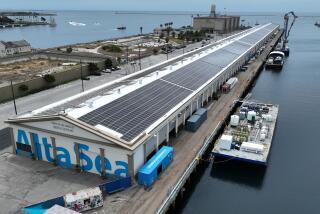Oil Cleanup Center Will Be Unveiled : Port Hueneme: The $70-million regional facility is the first of five to be built nationwide by a consortium of petroleum companies.
A consortium of major oil companies today will dedicate the nationâs first regional oil cleanup center in Port Hueneme, which ultimately will be capable of handling catastrophic spills off the coasts of California and Hawaii.
Officials acknowledged that the oil spill response center will not be fully operational until next summer, but said they could offer limited help to state and regional agencies in mopping up a moderate spill in the Pacific Ocean.
At a ceremony today, oil cleanup officials will unveil the $70-million center recently completed near the docks at the Port of Hueneme. It is the first of five regional centers to be built at strategic ports nationwide that could tackle a 9-million-gallon spill, the size of the one caused by the Exxon Valdez in Alaska three years ago.
âItâs a time to pause and reflect on the progress that weâve made and where we have to go,â said Skip Onstad, general manager of the nonprofit Marine Spill Response Corp. âWe now can stop concentrating on building the facilities and start concentrating on readying our people to respond to a spill.â
Employee training already has begun at the facility using one of the worldâs largest oil skimmers, which operates like a giant vacuuming machine, aboard the chartered 160-foot Taylor Tide. The Port Hueneme center will get its own 210-foot vessel, the California Responder, in January when it is completed.
The corporation, financed by 41 companies that transport and drill for oil in U. S. waters, is spending more than $900 million to open five response centers nationwide to comply with the Oil Pollution Act of 1990, said John R. McLaurin, a corporation spokesman.
That law, passed after the Valdez incident, requires oil companies to develop contingency plans for large spills or face a prohibition from operating in U. S. waters. The Marine Spill Response Corp. was established in 1990 to carry out such a plan.
Once fully staffed, the Port Hueneme center will employ 71 workers, 55 locally, and will pump $3 million in salaries into the local economy, McLaurin said. The center has yet to fill 24 jobs, primarily for cleanup workers, who would earn an annual $18,000 to $40,000.
The corporation also plans to station 210-foot oil recovery vessels with eight crew members and equipment at ports in San Francisco and Honolulu, satellites of the Port Hueneme center. The other regional centers will be located in Puget Sound, Lake Charles in Louisiana, Miami, and in the New York-New Jersey harbor area.
Officials estimated that if the corporation had existed five years ago, its employees would have responded to a dozen spills nationwide by now, including two in the Port Hueneme centerâs region that stretches from the California coast to Hawaii.
Henry Feniger, president of the Santa Barbara-based group, Get Oil Out, said he is pleased that oil companies are preparing for spills. But, he said, oil cleanup technology remains woefully inadequate.
âAnything that can be done to mitigate a catastrophic oil spill is welcome, thereâs no question about that,â said Feniger, who formed the group in the wake of the 1969 Santa Barbara spill. âIâm just saying that at this point in time, we could not contain a major oil spill,â he said.
Onstad acknowledged that the speed and cleanup of spills depend on weather conditions, the type of oil, and its thickness or capacity to absorb water. He said that once the oil is removed from the spill area, it can either be refined, recycled or, as a last alternative, placed in a landfill.
But from here, Onstad said, cleanup capability can only improve. âThereâs never before been an organization to respond to the very large oil spills.â
When the Port Hueneme center is not training employees or responding to a spill, McLaurin said, its workers will focus on developing better cleanup techniques.
More to Read
Sign up for Essential California
The most important California stories and recommendations in your inbox every morning.
You may occasionally receive promotional content from the Los Angeles Times.










